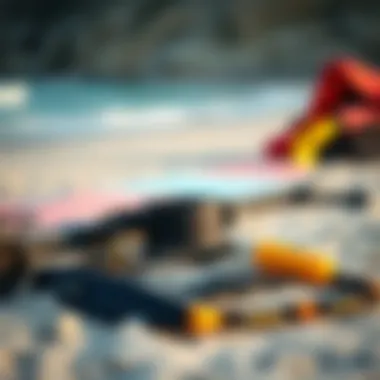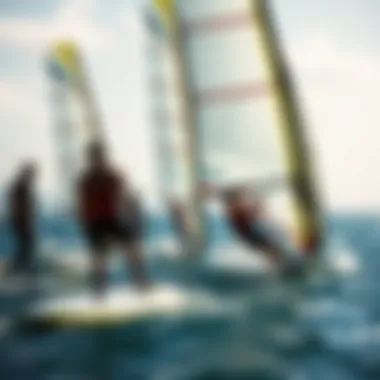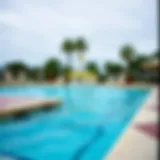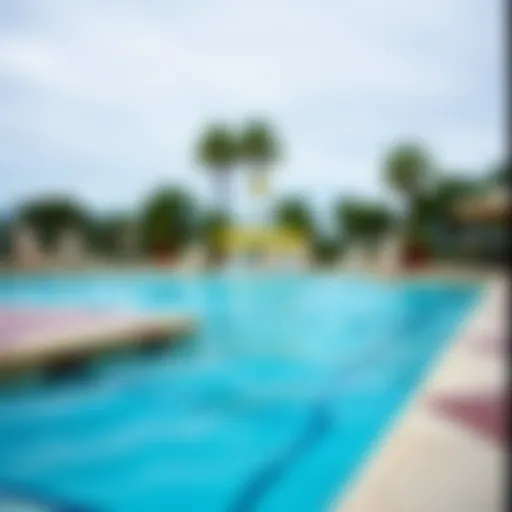Mastering Wing Foil Lessons: A Guide for Enthusiasts


Intro
Wing foiling has emerged as a thrilling watersport that combines elements of windsurfing, kitesurfing, and traditional surfing. This relatively young sport offers enthusiasts a unique way to glide over water, harnessing wind power while standing on a board supported by a hydrofoil. As this exciting trend continues to gain traction, it’s essential to understand the core components of effective wing foil lessons.
Whether you are just starting out or you're looking to refine your skills, delving into the techniques, safety measures, and the right equipment can drastically enhance your experience on the water. The following sections will explore the essentials of mastering wing foil, turning tumultuous waves into smooth sailing while ensuring safety and enjoyment throughout this learning process.
Expert Insights
Wing foiling represents a fascinating evolution in watersports. With its growing popularity, staying updated on the latest trends is crucial for both learners and seasoned pros.
Latest Trends in Watersports
As wing foiling climbs in prominence, various developments have unfolded in terms of gear, techniques, and learning environments. Here are some current trends worth noting:
- Compact Wing Designs: Modern wings are becoming lighter and smaller, enabling easier handling and enhanced control.
- Use of Foil Technology: Advanced hydrofoils are now designed to provide improved stability at various speeds, unlocking new performance levels for savvy riders.
- Environmental Awareness: More riders are becoming conscious of their ecological impact, leading to a rise in the use of sustainable materials and eco-friendly practices in both equipment selection and riding techniques.
Each of these advancements plays a significant role in enhancing the overall experience for wing foiling enthusiasts, ensuring they can enjoy the sport while contributing to its sustainable future.
Safety Protocols and Best Practices
Equipped with thrilling opportunities, wing foiling also comes with its own set of dangers. Understanding and adhering to rigorous safety protocols can significantly reduce risks. Some key practices include:
- Always wear appropriate personal flotation devices while in the water.
- Inspect your equipment before heading out; ensure everything is in proper condition.
- Choose locations wisely; avoid crowded areas, strong currents, or conflicting watercraft.
Remember: Safety first! It’s better to be overly cautious than to put yourself or others at risk.
With these precautions and trending insights in mind, both new and experienced riders will be better prepared to embrace the excitement of wing foiling.
Equipment Recommendations
Choosing the right equipment is key to mastering wing foiling successfully. As every rider's needs differ, having an understanding of essential gear for various skill levels is vital.
Must-Have Gear for Beginners
For those just stepping into the world of wing foiling, certain items are basic necessities:
- Wing: Opt for a medium-sized wing that's easy to control, as larger wings can be overwhelming for newcomers.
- Board: A wide and stable board is essential, as it provides the balance needed while learning.
- Foil: Beginners should choose a foil with a larger surface area; this will increase lift and help maintain stability.
Advanced Equipment for Pros
Once you have mastered the fundamentals, upgrading your equipment can take your performance to the next level:
- High-Aspect Foil: This design minimizes drag while maximizing speed, perfect for advanced maneuvers.
- Performance Wing: Look into wings that are specifically engineered for superior speed and handling, providing an exhilarating experience.
- Lightweight Board: As your skills improve, transitioning to a lighter board can enhance responsiveness and help with more complex tricks.
Ultimately, investing wisely in the right equipment can dramatically impact your journey in wing foiling, allowing for an enriching experience whether you sail smoothly or tackle challenging waves.
Foreword to Wing Foiling
Wing foiling is a comparatively new discipline in the expansive world of watersports, capturing the attention of enthusiasts for its unique blend of adrenaline and grace. Understanding its foundations is crucial, especially for newcomers eager to delve into this thrilling activity. This section lays the groundwork, shedding light on what makes wing foiling an attractive choice for both recreational individuals and serious athletes.
What is Wing Foiling?
Wing foiling combines elements of windsurfing, kitesurfing, and surfing, offering a distinct experience on the water. It involves using a wing - a large inflatable sail - that allows the rider to harness wind power while being elevated on a hydrofoil board. When executed properly, the rider can glide gracefully above the water surface, providing an experience that feels almost ethereal.
What sets wing foiling apart from other water sports is its versatility. Riders can comfortably adapt to various wind conditions and water types, whether they're in a calm bay or facing some choppier waters. This adaptability is a significant reason why wing foiling is becoming a go-to sport for so many.
The simplicity of equipment is another advantage. Unlike kites or complex sailing rigs, wing foiling equipment is relatively easy to set up and transport. Most riders find they can rig their gear in a matter of minutes, making it an excellent option for spontaneous outings.
History of Wing Foiling
The roots of wing foiling can be traced back to the early 2000s, with various prototypes and concepts being tested by dedicated water sports enthusiasts. However, it wasn’t until the late 2010s that wing foiling began to gain significant traction across the globe. Key innovators influenced the modern iterations we see today through a relentless pursuit of performance and usability.
The design of the wing itself has evolved remarkably. Traditional windsurfing technology laid the groundwork, but modern wings have benefited from advances in materials and aerodynamics. This evolution means the equipment is not only lighter and easier to manage, but also delivers improved performance, inspiring newer generations to take to the water.
As the sport continues to grow, it draws in riders from various paddling and wind sports backgrounds, fuelling a dynamic community of learners and innovators. With its rising profile, wing foiling presents vast opportunities for enthusiasts to refine their skills and enjoy the thrill of flying above water.
“The beauty of wing foiling lies not just in the act of riding; it’s the unison between the wing, water, and wind that captures the spirit of freedom.”


In summary, this introduction to wing foiling not only establishes what the sport entails but also provides a glimpse into its exciting history. This groundwork sets the stage for delving deeper into techniques, safety, and lesson structures. With a solid grasp of these fundamentals, you can better appreciate what it means to master the art of wing foiling.
Understanding the Equipment
When it comes to wing foiling, the equipment you choose plays a pivotal role in not just your performance but also your safety. Familiarity with the components allows for better handling of the rigors of this dynamic sport. Getting a decent grasp of the gear is likened to understanding the secret sauce of a cherished family recipe—you want to ensure each ingredient is up to par to achieve the best possible outcome.
Essential Gear for Wing Foiling
In order to ride the waves efficiently, you'll need a few critical components. First on the list is the wing itself—this is the most visual part of the sport, and it heavily influences your ride. Much like a kite, the wings have varied sizes and designs tailored for different skill levels and wind conditions.
Next, there's the board, which should be balanced in terms of floatation and volume to provide stability, especially during take-off. These boards come in various shapes, catering to especially varied needs. Your choice of board might feel like selecting a knife for precise cutting; the one you choose will significantly affect your ability.
Finally, don’t skip on the leash, which is your lifeline. This helps ensure that your wing stays attached even if you take an unplanned dip. One might even consider the leash a trusty sidekick—always there to keep your gear in line.
Upholding the importance of choosing quality gear cannot be overstated. Here’s a recap:
- Wing: Size and design based on your experience and wind conditions.
- Board: Stability options should align with your skill level.
- Leash: Your connection to ensure you stay safe and your gear remains close.
Choosing the Right Wing
Selecting the right wing is akin to finding the perfect pair of shoes. Size matters, but so does design and flexibility. Beginners might gravitate towards larger wings with more surface area for easier lift, while advanced riders often lean toward smaller, more maneuverable options. The trick lies in understanding what works best for you.
When choosing a wing, consider:
- Wind Conditions: Lighter winds necessitate a larger wing for adequate lift.
- Riding Style: Are you aiming for speed and tricks? A smaller, more agile wing might be your best bet.
- Personal Preferences: Ultimately, it’s about what feels right when you’re on the water.
Really diving into these factors will allow you to harness the wind's power effectively and confidently.
Board Selection: Factors to Consider
The board is not just a flat piece of equipment; it’s your escape pod in the open waters. A well-chosen board can elevate your experience from simply okay to downright exhilarating. When selecting your board, consider the following:
- Volume and Floatation: A higher volume is beneficial for beginners as it offers stability.
- Shape: Boards can range from wide and short for stability to long and narrow for speed and maneuverability. Find out where you feel comfortable.
- Material: Boards can be made of various materials including foam and fiberglass—each offering different performance attributes.
In essence, think of your board as your personal chariot; finding the one that fits your style will enhance your speed and enjoyment on the water.
Remember: Choosing suitable equipment can drastically improve your skills and joy in wing foiling—treat it well, and it will reward you.
For more detailed information, you might check out resources at Britannica and community forums like Reddit. Dive deep into conversations and get the lay of the land before hitting the water.
Fundamental Techniques
The fundamental techniques of wing foiling are the building blocks that can make or break your experience on the water. Whether you’re just starting or looking to improve, grasping these basics is essential to elevate your skills and enjoy the ride. A solid understanding of these techniques not only enhances your confidence but also significantly improves your performance. After all, at the core of wing foiling lies the relationship between control, balance, and technique.
Proper Stance and Balance
Getting your stance right is perhaps the first step toward becoming a competent wing foiler. While it may seem straightforward, the nuances can take time to get used to. The right stance ensures that your weight is distributed evenly between your feet, helping maintain equilibrium.
- Feet Placement: Position your feet parallel to the board, generally shoulder-width apart. This gives you a stable base.
- Weight Distribution: Lean slightly back, allowing your heels to anchor you to the board while giving the wing room to lift you off the water.
- Core Engagement: Your core muscles play a pivotal role in maintaining balance. Always keep them engaged as this will allow for better responsiveness to shifts in wind and water conditions.
Practicing different stances while stationary before heading into the water can help you acclimate your body to the proper positioning.
Mastering Launch Techniques
Launching into the wind is often one of the most exciting parts of wing foiling, but it comes with its challenges. An effective launch can lead to smooth rides, whereas a poor one might leave you floundering.
Here’s how to ace the launch:
- Positioning: Align your body against the wind and keep the wing at about a 45-degree angle in front of you.
- Taking Off: When you feel a gust of wind, push the wing upward while stepping onto the board. Your instincts will guide you on when to lift off.
- Smooth Transition: Once airborne, ensure that the wing is aligned with the wind, allowing it to catch as much air as possible. This leads to an upward thrust that lifts the board from the water.
By practicing these steps repetitively, you’ll build muscle memory that translates into seamless launches over time.
Turning and Maneuvering
As you progress in wing foiling, being able to turn and maneuver is crucial. These skills not only add flair to your riding style but also enhance your ability to navigate varying wind conditions.
- Initiating Turns: To turn, lean in the direction you want to go. This helps shift your weight and initiates the turn.
- Using the Wing: Angling the wing can greatly affect how tight or wide your turns are. Pull the wing closer to your body for sharper turns and stretch it out for wider arcs.
- Head and Shoulders: Always look in the direction you want to go; this engages your entire body in the maneuver, leading to smoother transitions.
Learning how to effectively turn can breathe life into your sessions and make riding feel more natural.


"Mastering wing foiling is an ongoing journey; consistency in practicing fundamental techniques lays the groundwork for advanced maneuvers."
For further reading and resources, you can check out Wikipedia's entry on Wing Foiling or join discussions on wing foiling on platforms like Reddit.
Incorporating these fundamental techniques into your routine will undoubtedly enhance your skills, making each session on the water a rewarding experience.
Safety Protocols
Safety is paramount when engaging in wing foiling, as it ensures not only the enjoyment of the sport but also the well-being of all participants. Recognizing that the water can be unpredictable, especially when dynamic wind conditions are at play, understanding and adhering to safety protocols can't be overstated. This section covers the essential elements of staying safe while wing foiling, spotlighting key considerations such as local regulations, suitable gear, and recognizing environmental hazards.
Understanding Local Regulations
Before hitting the water, it’s imperative to familiarize yourself with the local regulations governing wing foiling. Each region may impose specific rules that dictate where and when you can practice this sport. For instance, certain beaches may have designated areas for kiteboarding or wing foiling, while others might prohibit the activity altogether. This helps to minimize conflicts with other water users or protect sensitive environments.
- Local Guidelines: Always check with relevant authorities or local clubs, often available on municipal websites or local marine agencies, to understand any restrictions or safety zones.
- License Requirements: Some areas may require permits or licenses. If you're in popular wing foiling spots like Hood River in Oregon, it's wise to get these sorted before launching.
- Community Recommendations: Local enthusiasts often know the ins and outs. Engaging with wing foiling communities can provide insights into unwritten rules or informal guidelines that can enhance your experience.
Personal Protective Equipment Recommendations
Equipping yourself with the right personal protective equipment (PPE) can significantly reduce the risk of injury while wing foiling. Safety gear serves as your first line of defense against potential mishaps. Consider the following essentials:
- Helmet: A well-fitting helmet is essential, particularly for beginners or when tackling more challenging conditions. Look for a water sports-specific model that offers protection without compromising on comfort.
- Impact Vest: This provides buoyancy as well as protection against falls and collisions. Opt for a vest that allows freedom of movement but offers adequate coverage at the same time.
- Wetsuit or Drysuit: Depending on the water temperature, a wetsuit can keep you warm and afloat should you fall in. Very cold conditions might necessitate a drysuit.
- Footwear: Shoes designed for water sports can prevent injuries to your feet and provide better grip when moving on the board.
Recognizing Hazards: Wind and Water Conditions
The elements can be both a friend and foe in wing foiling. Recognizing potential hazards associated with wind and water conditions is crucial for a safe experience. Here are a few key aspects to remain vigilant about:
- Wind Patterns: Understanding local wind patterns can make or break your session. Offshore winds, for example, can push you away from the shore, while strong onshore winds may lead to dangerous conditions. Always check the forecasts before venturing out.
- Water Currents: Be aware of tide changes and currents, as they can have significant effects on your riding experience. Currents can increase the challenge and also impact your ability to return to shore.
- Obstacles: Look out for any protruding rocks, jetties, or other watercraft. These can pose serious risks if you’re not vigilant.
- Weather Changes: Keep an eye on changing weather conditions. Sudden storms can appear quickly, demanding immediate caution.
"Taking the time to understand your environment and prepare accordingly can turn a potentially hazardous day into a productive and enjoyable one."
In summary, adopting comprehensive safety protocols in wing foiling is indispensable. By understanding local regulations, utilizing appropriate personal protective equipment, and recognizing environmental hazards, you elevate not only your own safety but also that of others around you. This foresight ensures that your journey into the world of wing foiling is as enriching and enjoyable as possible.
For more guidelines on water sports safety, visit websites like US Coast Guard or check local regulations through NOAA's Office of Reserve.
Lesson Structure and Progression
When it comes to mastering any skill, the structure of lessons plays a pivotal role in guiding learners through the maze of techniques and concepts. The realm of wing foiling is no exception. A well-organized lesson structure not only establishes a clear path for the practitioner but also allows for incremental growth in skills. This article section delves into key components of effective lesson structure, emphasizing how thoughtful planning can lead to substantial improvements in performance and confidence.
Designing Effective Lesson Plans
An effective lesson plan is the backbone of any successful wing foiling instruction. To lay the foundation, one must consider a few essential elements:
- Objectives: Clearly defined goals guide the lesson focus and provide a destination for learning. For instance, a lesson might aim to teach the student how to maintain balance on the board.
- Duration and Flow: Each session should be carefully timed to keep attention without overwhelming the learner. Finding the right rhythm between instruction, practice, and feedback keeps enthusiasm levels high.
- Content Variety: Mixing theoretical explanations with practical demonstrations prevents monotony. For example, a lesson on turning could combine a discussion on posture with on-water trials to demonstrate proper technique.
Ultimately, the interplay between structure and flexibility can create an effective framework for students to absorb and execute new skills.
Progressive Skill Development
Skill development in wing foiling doesn’t happen overnight. It's akin to stacking building blocks; each skill is a block that needs a solid base before the next one can be added. Here are some strategies for effective skill development:
- Start Simple: Begin with fundamental skills like balance and control before moving onto complex maneuvers. Mastering the basics builds confidence and sets the stage for advanced techniques.
- Incremental Challenges: As the student progresses, gradually increase the difficulty of tasks. If a learner is comfortable with controlling speed on flat water, it’s time to introduce light winds or slight waves for the next challenge.
- Evaluate and Adapt: Regular evaluations help tailor the learning experience. If a student struggles with a particular skill, it’s essential to reassess goals and possibly refocus on foundational techniques. Learning is often non-linear, and readiness varies tremendously among individuals.
By structuring lessons around progressive development, students are more likely to feel a sense of accomplishment, encouraging them to push forward.
Incorporating Feedback Loops
Feedback is a crucial part of any learning process, akin to having a lighthouse guiding a ship through treacherous waters. In wing foiling, incorporating feedback loops can significantly enhance skill acquisition. Consider these points when designing feedback mechanisms:
- Immediate Feedback: Providing real-time observations during practice sessions can help students to correct mistakes before they become habits. For example, if a rider is leaning too far back during a maneuver, pointing it out promptly can lead to immediate adjustments.
- Structured Reflection: Encourage students to reflect on their performances after each session. This could be through guided questions like "What did you find challenging today?" or "How did your approach change throughout the lesson?"
- Peer Feedback: Encouraging students to give constructive feedback to each other fosters a collaborative learning atmosphere. Learning from peers might reveal insights that an instructor isn’t aware of.
These feedback loops not only promote awareness but also instill a sense of community among learners, which can be a powerful motivator in any sport.
"The essence of education is not to brand the student with knowledge, but to give them the tools to find it for themselves."
In essence, effective lesson structure intertwined with progressive skill development and robust feedback loops creates a comprehensive framework for mastering wing foiling. This approach not only enhances individual performance but also fosters a deeper understanding of the sport as a whole. For more resources on structured lesson plans, you could visit Wikipedia or explore Reddit for community insights.
Learning Environments
The significance of learning environments in wing foiling cannot be overstated. The right environment not only enhances skill acquisition but also contributes to the overall enjoyment and safety of the sport. In the realm of wing foiling, the natural surroundings, wind conditions, and water characteristics shape the learning experience profoundly. Selecting an ideal location can ignite a passion for the sport, while an unsuitable one may lead to frustration and potential hazards.


A few specific elements to consider when evaluating learning environments include accessibility, water quality, and selected space for practice. For instance, calm waters with gentle breezes are ideal for beginners. A location that allows for an easy launch and retrieval of equipment is also vital, minimizing the hassle that often discourages newcomers.
Moreover, understanding the nearby facilities is also beneficial. Access to local shops for equipment, rental services, and instructional classes can aid both novices and seasoned practitioners. All these factors, when thoughtfully considered, contribute to a more productive learning experience and create an atmosphere where skills can flourish.
Identifying Ideal Locations
When it comes down to identifying ideal locations for learning wing foiling, seeking out spots with predictable and manageable wind conditions is crucial. Beginner-friendly environments often feature flat water and consistent winds that allow for gradual skill progression without overwhelming new riders.
- Lakes and Ponds: These are often the best choices for novices. Their calm waters provide a safe space to practice without the unpredictable waves of the ocean.
- Coastal Beaches: Opt for shores that are not prone to extreme currents or tides. These locations usually offer spacious areas for launching and recovering.
- Resorts or Clubs: Many of them have designated areas for water sports, providing a controlled environment conducive for learning.
Additionally, local knowledge can be a significant asset in choosing a spot. Talking to local instructors or seasoned foilers can yield valuable insights about hidden gems or preferred sites that may not be on the radar.
Navigating Variable Weather Conditions
Engaging with variable weather conditions is part and parcel of wing foiling, but it can also serve as a learning opportunity. Understanding the nuances of wind patterns, water temperatures, and the effects of weather on riding conditions is essential. As winds can change unexpectedly, learning to read the environment will grant the rider enhanced safety as well as insight into the timing of their sessions.
- Wind Patterns: Knowing if the wind is offshore, onshore, or cross-shore helps assess potential hazards before heading out.
- Water Conditions: A smooth surface can easily turn choppy depending on wind strength. Getting familiar with regional tides and currents can prevent nasty surprises.
- Weather Forecasts: Keeping an eye on local weather apps or websites helps in planning sessions. Understanding how temperature changes affect wind can inform the best times to head out.
Staying informed and prepared not only enhances your ride but also ensures your safety on the water. Each session also becomes a learning moment through the changing conditions, blending knowledge with practical experience.
In summary, the learning environment for wing foiling is multifaceted, requiring thoughtful selection based on several factors. By recognizing ideal spots and understanding how to navigate varying weather conditions, learners can enrich their experience and steadily progress in this exhilarating sport.
Community and Resources
In the world of wing foiling, building a network of connections and accessing varied resources is as critical as mastering balance or controlling your kite. Communities provide support, shared knowledge, and opportunities for growth. Whether you are a lateral thinker or someone who prefers a methodical approach, being part of a group can significantly improve one's skill set and overall enjoyment in the sport. Here’s a closer look at the vital components of community and resources in the realm of wing foiling.
Finding Local Instructor Networks
Establishing access to proficient local instructors is paramount. Not only do they offer personalized advice, but they also understand the nuances of the local environments. When locating these networks, consider:
- Local shops: Many surf and kite shops can connect you with certified instructors or experienced local riders.
- Community boards: Often found on websites tailored for watersports, these boards often have postings from instructors and schools.
- Word of mouth: Never underestimate the power of a friendly chat at the beach or on the water—sharing experiences can lead you right to the best local talent.
By connecting with a local instructor network, you’ll likely gain insights into not just techniques but also local weather conditions that might influence your practice. A good instructor can also be your first line of defense against developing bad habits.
Online Platforms for Learning
In this digital age, online resources have opened doors that didn’t exist before. The internet can be a treasure trove for prospective wing foilers. Here’s what to consider:
- Video tutorials: Platforms like YouTube have a plethora of tutorials from both professionals and enthusiasts. These can give visual context to the techniques you may struggle with in person.
- Discussion forums: Websites such as Reddit host communities where you can ask questions, share experiences, and learn from others.
- Online courses: Some companies offer structured online wing foil courses that can be a great supplement to in-person lessons.
Utilizing online platforms can enable a wider exchange of information and ideas, helping you to nurture a deeper understanding of the sport at your own pace.
Joining Wing Foil Communities
Beyond instructors and online learning, immersing yourself in wing foiling communities can enhance your experience in ways you might not expect.
- Facebook groups: Look for regional groups dedicated to wing foiling. These spaces allow for sharing tips, making connections, and even organizing meet-ups.
- Local clubs: Check out if there's a local wing foiling club. Clubs foster camaraderie, socialize, and often share equipment, which can lessen the financial burden of trying out new gear.
- Event participations: Engage in competitions or local meet-ups. You may not be ready for competition, but they can offer great networking opportunities and insights into the sport.
Being involved in a community not only helps you to learn faster but also makes the entire experience more enjoyable. Remember, every expert was once a beginner.
"Surrounding yourself with people who are just as passionate about wing foiling can be an incredible motivator, turning challenges into shared experiences."
The End: The Future of Wing Foiling
The future of wing foiling is bright and filled with possiblities that could truly reshape watersports. As enthusiasts continue to embrace this relatively new activity, we can expect a wave of innovation in techniques, equipment, and community engagement. This is significant not merely for the sport's growth, but also for fosterng a culture that values sustainability and fun in a shared environment.
Emerging Trends in the Sport
In the coming years, numerous trends are likely to emerge within the wing foiling community:
- Innovative Equipment Design: Manufacturers are focusing on developing lighter and more durable materials. Emerging composites and designs will likely enhance performance while also improving safety features.
- Increased Accessibility: As the sport gains popularity, more locations will open up designated areas for wing foiling, providing safe environments for both novices and seasoned veterans. Rentals, lessons, and schools will also expand, making it easier to dive right in.
- Sustainability Initiatives: The environmental impact of watersports is becoming a hot topic. Many organizations are committed to keeping our oceans clean and might adopt eco-friendly practices in their operations and events, from bioplastics to clean-up initiatives.
- Community-Centric Events: Expect to see more local competitions, social gatherings, and clinics designed to unite and inspire foilers of all levels. This will create an inclusive atmosphere fostering connections among enthusiasts.
"As wing foiling evolves, so does the community. We’re just getting started, and the possibilities are limitless!"
Encouragement for Continuous Learning
The journey of mastering wing foiling is ongoing, requiring dedication and a willingness to learn. Here are several encouragements to keep you motivated:
- Skill Development: Embrace the learning curve. Each outing can reveal new techniques or strategies that can enhance your performance on the water. Reflect on your experiences, noting what worked and what didn’t.
- Seeking Knowledge: Utilize available resources. Online forums, instructional videos, and local communities are great for sharing insights and tips. Engaging with others allows you to exchange knowledge and grow collectively.
- Professional Guidance: Consider lessons with qualified instructors. Even advanced foilers benefit from coaching feedback. An expert can provide perspectives and techniques that you might overlook on your own.
- Stay Curious: Challenge yourself to learn new tricks or explore various locations. Diversifying your approach is not just beneficial for building skills, but also fortifies the excitement, keeping the passion alive.
In summary, the future of wing foiling promises excitement and growth. By staying engaged, curious, and open to new ideas, participants not only enhance their own experiences but contribute positively to the sport's evolution. The waters are calling, and as they say in the surfing community, "ride the wave of change!"
For additional resources and community connections, check out Wikipedia, Britannica, or engage with the community on Reddit.
It's time to get out there and embrace the wind!







